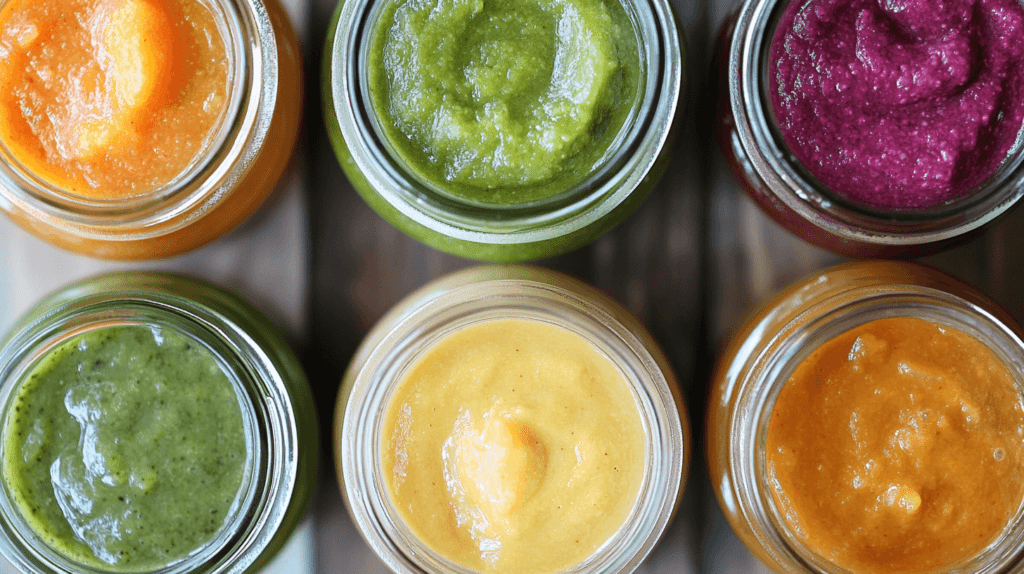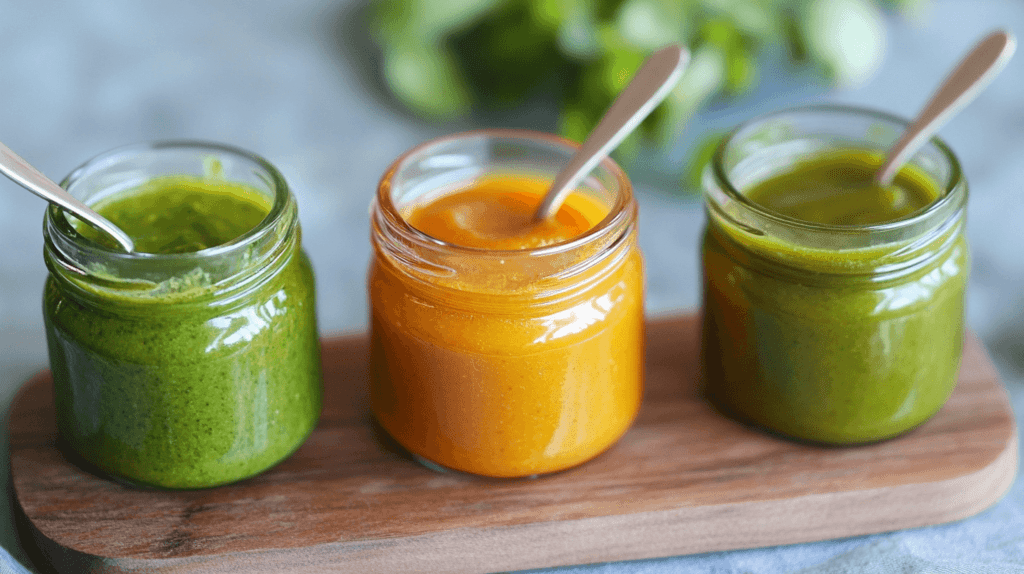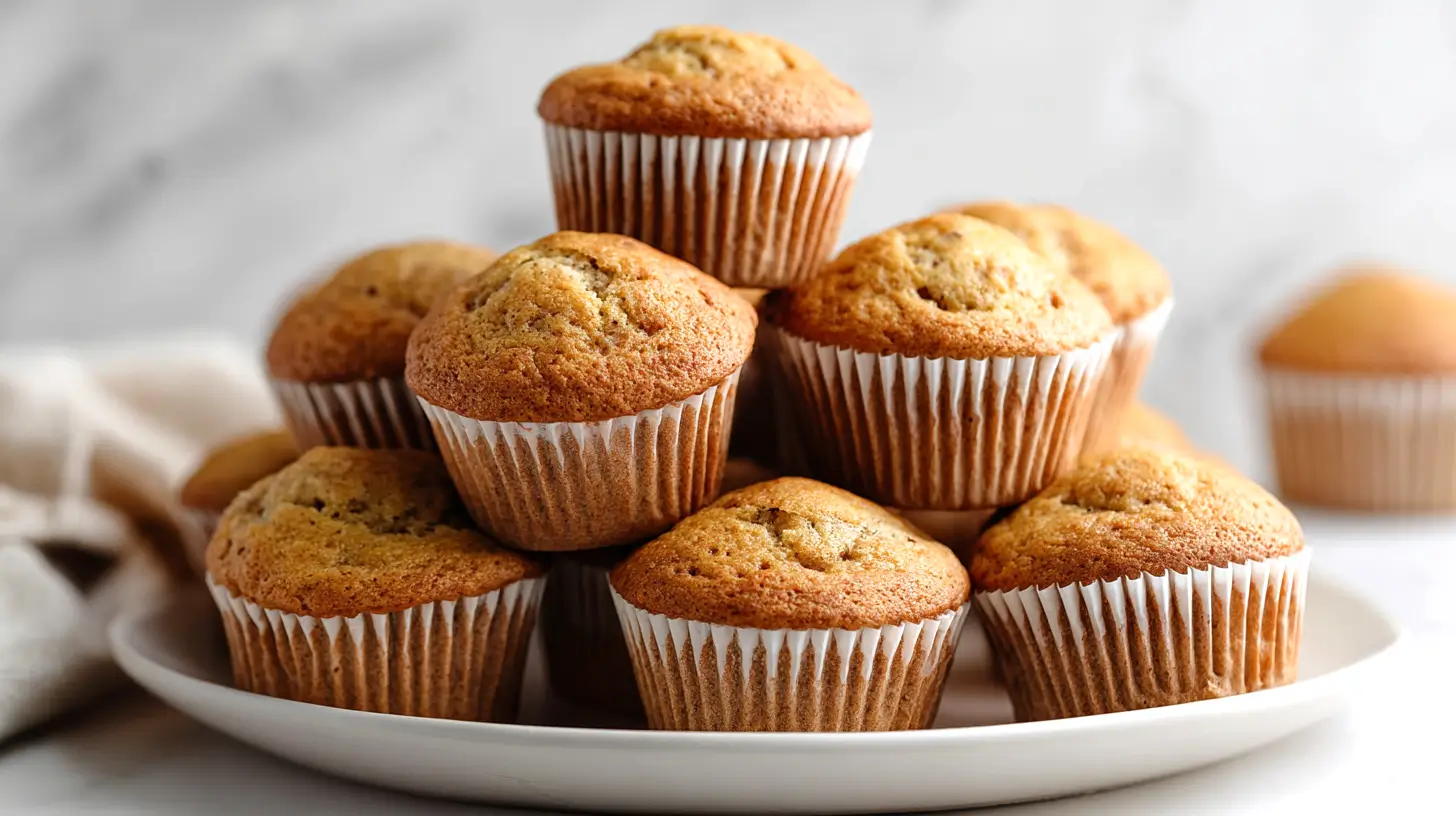Let’s talk about easy homemade baby food recipes, perfect for beginners. Whether you’re a new mom or a seasoned parent looking for fresh ideas, this guide is here to help. Making baby food at home can be fun, nutritious, and a great way to bond with your little one. Let’s get started!

This site includes affiliate links; you can check the disclosure for more details.
Why Choose Homemade Baby Food?
- Cost-Effective: Homemade baby food is often more affordable than store-bought options. You can save money while ensuring your baby enjoys fresh, healthy meals.
- Healthier Ingredients: When you make baby food at home, you control what goes in it. This means no unwanted additives or preservatives, just wholesome goodness.
- Taste and Variety: Homemade meals can expose your baby to a broader range of flavors and textures, setting the stage for a lifetime of healthy eating habits.

Getting Started: What You Need to Make Baby Food
- Equipment: A blender or food processor, a steamer basket, ice cube trays for freezing portions, and small storage containers.
- Choosing Ingredients: Opt for fresh, organic fruits and vegetables when possible. Look for produce that’s in season to ensure the best taste and nutritional value.
- Safety First: Always wash your hands and kitchen tools thoroughly. Wash and peel any fruits and vegetables as needed.

Simple Baby Food Recipes
Basic Pureed Veggies:
- Ingredients: Sweet potatoes, carrots, peas, or green beans.
- Method: Steam the veggies until tender. Blend them with a little water until smooth. You can mix different vegetables for variety.
Fruit Medley:
- Ingredients: Apples, pears, bananas, or avocados.
- Method: Steam apples and pears until soft. Mash bananas or avocados with a fork. Blend until it is just right.
Rice Cereal:
- Ingredients: Brown rice.
- Method: Grind the rice in a food processor. Cook it with water until it’s soft. Blend for a smooth texture.

More Simple Baby Food Recipes for Beginners
Creating homemade baby food doesn’t have to be complicated. Check out these simple and healthy recipes to kick off your exciting journey!
1. Sweet Potato and Pear Puree:
- Ingredients: 1 medium sweet potato, 1 ripe pear.
- Method: Peel and chop the sweet potato and pear. Steam or boil the sweet potato until soft, and steam the pear for a few minutes. Blend them together until smooth. This puree offers a sweet and creamy texture, ideal for babies just starting on solids.
2. Peas and Carrot Delight:
- Ingredients: 1 cup of peas, 2 medium carrots.
- Method: Steam or boil the carrots and peas until tender. Puree them together, adding a little water or breastmilk/formula to reach the desired consistency. This green puree is not only visually appealing but also full of essential nutrients.
3. Banana and Avocado Blend:
- Ingredients: 1 ripe banana, 1 ripe avocado.
- Method: Mash the banana and avocado together until you achieve a smooth consistency. This recipe is great for busy days and has healthy fats and vitamins.
4. Apple and Blueberry Mash:
- Ingredients: 2 apples, a handful of blueberries.
- Method: Peel and chop the apples, then cook them with the blueberries until soft. Mash or blend for a slightly textured puree. You will get antioxidants and a tasty flavor with this combo.
5. Butternut Squash and Cinnamon Puree:
- Ingredients: 1 butternut squash, a pinch of cinnamon.
- Method: Peel and chop the butternut squash. Steam until tender, then blend with a pinch of cinnamon. This puree brings a fresh taste and a smooth, comforting texture.
6. Broccoli and Cauliflower Mix:
- Ingredients: Equal parts broccoli and cauliflower.
- Method: Steam both vegetables until soft. Blend them together, adding water or your baby’s milk to achieve the right consistency. This mix is a great way to introduce your baby to different vegetables.
7. Oatmeal and Apple Breakfast:
- Ingredients: Rolled oats, 1 apple.
- Method: Cook the oats as per the package instructions. Peel, core, and chop the apple, then cook until soft. Blend the apple into the oatmeal for a wholesome breakfast option.
8. Pear and Spinach Combo:
- Ingredients: 1 ripe pear, a handful of spinach.
- Method: Steam the spinach leaves until wilted and cook the pear until tender. Blend together for a nutrient-packed green puree.
9. Sweet Pea and Mint:
- Ingredients: 1 cup of peas, a few fresh mint leaves.
- Method: Cook the peas and steam the mint leaves for a few minutes. Blend together for a refreshing and unique flavor.
10. Pumpkin and Rice Pudding:
- Ingredients: Pumpkin puree, cooked rice, a dash of cinnamon.
- Method: Mix cooked rice with pumpkin puree. Add a dash of cinnamon for flavor. This is a great way to introduce textures to your baby.
These recipes are super easy and healthy, great for beginners in the homemade baby food world. Feel free to try different combinations and textures to keep mealtime exciting and nutritious for your little one as you get more comfortable!

Introducing New Foods to Your Baby
Starting solids is an exciting milestone, but it’s also a time to approach with care and patience. Here’s how to make the process smooth and safe for your baby.
One at a Time
When introducing new foods, start slow. Offer one new food at a time and stick with it for three to five days before trying another. This makes it easier to pinpoint any allergies or sensitivities. For example, start with mashed sweet potato one week, then move on to applesauce the next. Keeping it simple helps you track what works best for your baby.
Watch for Reactions
Always be on the lookout for signs that something isn’t agreeing with your baby. Common allergic reactions include rashes, diarrhea, or vomiting. If you notice any of these, stop the new food immediately and consult your pediatrician. Early awareness can prevent further discomfort and ensure your baby’s diet stays safe and enjoyable.
Be Patient
Babies don’t always love a new food on the first try—or even the second or third! It can take up to 10 exposures before they accept a new flavor. If they turn their head or make a face, don’t worry. Try again later or mix it with something they already like. Building a varied palate takes time, so stay consistent and encouraging.
Introducing new foods is as much about discovery as it is about nutrition. Celebrate the little wins and remember, it’s okay if it gets messy or takes a while. Each bite is a step toward healthy eating habits.

Storing and Freezing Tips
Refrigeration: Freshly made baby food can be stored in the refrigerator for up to 48 hours.
Freezing: Pour the pureed food into ice cube trays and freeze. Once frozen, transfer the cubes into freezer bags. They can be stored for up to three months.
Thawing and Reheating: Thaw frozen cubes in the fridge overnight. Reheat gently, ensuring the food is not too hot before serving.

Advanced Homemade Baby Food Recipes
Once your baby is comfortable with basic purees, you can start introducing more complex flavors and textures. This is an exciting phase as it opens up a world of culinary possibilities!
- Mixed Vegetable and Chicken Puree:
- Ingredients: Cooked chicken, sweet potatoes, peas, and carrots.
- Method: Steam the vegetables until tender and cook the chicken thoroughly. Blend everything together with a little water or your baby’s usual milk to achieve a smooth consistency.
- Banana and Avocado Mousse:
- Ingredients: Ripe banana and avocado.
- Method: Simply mash the banana and avocado together until you get a creamy, mousse-like texture. This is a great way to introduce healthy fats.
-
Lentil Stew:
- Ingredients: Red lentils, carrots, and apples.
- Method: Cook the lentils with diced carrots and apple until soft. Blend to a suitable consistency. Lentils are a great source of plant-based protein and iron.
Adding Herbs and Spices
Introducing mild herbs and spices is a great way to develop your baby’s palate. Avoid salt and sugar. Instead, opt for cinnamon, vanilla, mint, or mild curry powder to add flavor to fruits and vegetables.
Nutritional Considerations for Homemade Baby Food
Feeding your baby isn’t just about offering meals—it’s about making sure those meals support their growth and development. Here are some key points to keep in mind when planning their menu.
Iron-Rich Foods
By the time your baby reaches around six months, their natural iron stores from birth begin to run low. Including iron-rich foods in their diet is essential for healthy growth and brain development. Pureed meats like chicken or beef are excellent sources of iron. Lentils and beans are great plant-based options, and iron-fortified cereals can be an easy addition to their meals. Pairing these with foods high in vitamin C, like pureed fruits, helps their body absorb iron more effectively.
Avoiding Choking Hazards
Safety always comes first when introducing solids. Make sure the food you prepare is the right consistency for your baby’s developmental stage. For younger babies, smooth purees are ideal, while older babies can handle soft, mashed, or small pieces of food. Avoid hard or small items like raw carrots, whole nuts, or grapes that pose choking risks. Always supervise your baby during meals and cut food into safe, manageable sizes.
Dairy and Allergens
Introducing dairy and common allergens like eggs, nuts, or seafood can feel tricky, but it’s an important step. Always consult with your pediatrician before adding these foods to your baby’s diet. Start with small amounts and watch for any signs of an allergic reaction. If your baby tolerates these foods well, they’re a valuable addition to a balanced diet.
By keeping these nutritional considerations in mind, you can feel confident that your homemade baby food is safe, nutritious, and tailored to your baby’s needs.

Meal Planning and Preparation for Busy Parents
Making homemade baby food doesn’t have to be overwhelming. With a little planning, you can save time, reduce stress, and keep mealtimes fun and nutritious for your baby.
Batch Cooking
Preparing baby food in large batches is a game-changer. Cook and blend several portions of fruits, veggies, or proteins at once, then freeze them in small containers or ice cube trays. This way, you’ll always have healthy, homemade food ready to go, even on your busiest days. Just thaw what you need, and you’re all set. It’s a huge time-saver and ensures your baby gets nutritious meals without the hassle of daily prep.
Menu Variety
Babies need a wide range of nutrients to grow strong and healthy, so mix it up! Rotate between different fruits, vegetables, and proteins to expose your baby to various flavors and textures. For example, serve pureed carrots and peas one day and mashed sweet potatoes with chicken the next. This not only keeps meals interesting but also helps prevent picky eating as they grow.
Family Meals
Adapting family meals for your baby is another way to simplify food prep. For example, if you’re making roasted veggies for dinner, set aside a portion to steam and puree for your baby. It’s an easy way to include them in family mealtimes and helps them get used to the idea of eating with everyone. Plus, sharing meals as a family strengthens bonds and makes mealtimes more enjoyable for everyone.
With these strategies, feeding your baby can feel more manageable and less like a chore. A little planning goes a long way in creating happy, stress-free meals for you and your little one.
Engaging Your Baby in the Food Experience
Making mealtime interactive is a great way to help your baby develop essential eating skills. It’s not just about nourishment—it’s also about creating positive food experiences that set the stage for healthy habits.
Texture Exploration
Introducing new textures as your baby grows is an important step. Start with smooth purees, then gradually offer mashed or chunky foods. Once they’re ready, move on to soft finger foods like small pieces of banana or well-cooked veggies. Exploring textures helps your baby practice chewing and swallowing, which are essential for transitioning to solid foods.
Self-Feeding
Letting your baby take the lead with self-feeding might be messy, but it’s a big part of their learning journey. Offer soft finger foods or a pre-loaded spoon to let them practice. While you’ll probably end up cleaning the high chair (and maybe the floor), these moments help build their independence and coordination. Plus, it’s fun to see how proud they are when they get a bite on their own!
Responsive Feeding
Paying close attention to your baby’s hunger and fullness cues is key. Watch for signs like leaning forward and reaching for food when they’re hungry or turning their head away when they’re full. Respecting these cues helps your baby develop a healthy relationship with food. It’s about teaching them to eat when they’re hungry and stop when they’re satisfied.
By making mealtime interactive and enjoyable, you’re helping your baby learn more than just eating skills—you’re laying the foundation for a lifetime of positive eating habits. Try to embrace the mess and enjoy this special stage of discovery together.
Enjoying Seasonal and Local Produce
Making homemade baby food is an easy way to give your baby the freshest, most nutritious meals. Seasonal produce has natural flavor and is often packed with more nutrients than out-of-season options. Plus, when you buy from local farmers, you’re supporting your community and getting ingredients at their peak.
Seasonal Fruit Purees
Using fruits in season keeps meals exciting and full of flavor:
- Summer: Blend juicy peaches, nectarines, or sweet melons. These fruits are naturally refreshing and require little preparation.
- Fall: Apples and pears are perfect for purees. Cook them and add a tiny pinch of cinnamon for a warm, comforting taste.
- Winter: Pumpkin and sweet potatoes are ideal for hearty purees. Cook and blend them into a smooth, creamy consistency.
- Spring: Brighten meals with pureed berries or sweet peas. Their fresh, mild taste is perfect for introducing new flavors.
Local Veggie Ideas
Your local farmer’s market is a treasure trove for fresh, in-season vegetables. Look for options like carrots, squash, or green beans. These can be steamed and pureed for younger babies or cut into soft, bite-sized pieces for older ones learning to self-feed. When you choose local produce, you’re not just feeding your baby; you’re contributing to the local economy and getting the best possible quality.
Why It’s Important
Seasonal and local ingredients do more than just add flavor. They’re often fresher and packed with more nutrients, ensuring your baby gets the best start. Introducing a variety of tastes and textures sets the stage for healthy eating habits. Buying local also supports your community while reducing your food’s environmental impact.
With a little creativity and some seasonal inspiration, you can make mealtimes fun and nutritious for your little one.
Understanding Baby’s Nutritional Needs at Different Stages
As babies grow, their nutritional needs change. Here’s how to keep up with each stage.
6-8 Months:
At this age, iron-rich foods are key since the natural stores from birth begin to run low. Options like pureed chicken, lentils, or fortified cereals work great. Add mashed or pureed fruits and vegetables, such as bananas, sweet potatoes, or zucchini. Soft grains, like oatmeal, provide texture and nutrients, keeping meals balanced.
9-12 Months:
Your baby is ready to explore more textures. Start offering small, soft finger foods like diced fruits, cooked pasta, or steamed veggies. These help them learn to chew and self-feed. Yogurt or cheese adds calcium and healthy fats to their diet. Make meals fun by presenting a variety of colors and flavors.
12 Months and Beyond:
By this point, your little one can eat modified family meals. Chop food into tiny, manageable pieces to ensure safety. Focus on a balanced plate with protein, whole grains, vegetables, and fruits. Introducing more textures and combinations keeps mealtime interesting while supporting their growing needs.
Helpful Tips:
- Introduce new foods slowly to check for allergies.
- Keep portions small to avoid overwhelming them.
- Skip added salt, sugar, and honey until they’re older.
Mealtimes can be an adventure when you understand your baby’s needs.
Creative Homemade Baby Food Ideas for Beginners
Quinoa and Veggie Mash:
Combine 1/4 cup cooked quinoa, 1/4 cup steamed carrots, and 1/4 cup steamed peas. Blend until smooth for a creamy, nutrient-dense meal that’s gentle on little tummies. Quinoa is a fantastic source of protein and fiber, while carrots and peas add vitamins A and C. This blend introduces different flavors and textures for a well-rounded start.
Sweet Potato and Apple Bites:
Mix 1/2 cup mashed sweet potato, 1/4 cup applesauce, and 2 tablespoons of flour to create a soft batter. Cook small pancakes on a nonstick pan until golden on both sides. These bite-sized treats are perfect for self-feeding, helping babies develop hand-eye coordination. The natural sweetness from the apple and sweet potato makes them a hit with little ones.
Fish and Veggie Puree:
Blend 2 ounces cooked, deboned salmon with 1/4 cup steamed vegetables like broccoli or green beans. This puree is packed with omega-3 fatty acids for brain development and plenty of vitamins. Adjust the texture to suit your baby’s needs, from smooth for beginners to a chunkier consistency for older babies.
Tips for Introducing Textured Foods
- Go Slowly: Begin with slightly chunkier purees and gradually increase the texture.
- Offer Variety: Alternate between smooth, mashed, and small pieces to encourage exploration.
- Safety First: Always supervise meals and ensure food pieces are small and soft to prevent choking.
Make Mealtime Fun
- Colorful Meals: Create visually appealing plates with vibrant ingredients like carrots, spinach, or squash.
- Interactive Eating: Encourage your baby to touch and play with food—it’s messy but helps them explore.
- Family Time: Sit together during meals. Babies mimic adults, so it’s a great opportunity for them to learn.
Final Thoughts on Homemade Baby Food Recipes for Beginners
Making homemade baby food is an adventure filled with healthy choices, creativity, and fun. By using seasonal produce, understanding nutritional needs at different stages, and introducing a variety of textures and tastes, you are setting the foundation for a lifetime of healthy eating habits. Enjoy this special time with your baby and remember, the best ingredient you can add to any meal is a spoonful of love!





